Leadership in Business Organizations: A Comprehensive Report
VerifiedAdded on 2023/01/17
|18
|4446
|64
Report
AI Summary
This report provides a comprehensive analysis of leadership within leading business organizations. It begins by exploring fundamental leadership questions, key aspects of leadership, and various leadership styles, including autocratic and democratic approaches. The report then delves into organizational mission and vision, examining the contributions of individuals, leaders, and stakeholders. Furthermore, it investigates leadership strategies, change leadership, and organizational potential within the business context. A significant portion is dedicated to motivation theories, including intrinsic and extrinsic theories, as well as contemporary approaches like appreciative inquiry. The report also assesses potential leadership styles, identifying key strengths and challenges, and discussing personal development strategies. Part 2 focuses on servant leadership, providing an overview, examples of good practice, and potential challenges. It then critically evaluates Kevin Johnson's leadership style, identifying positive and negative factors, key stakeholders, and his personal brand, concluding with recommendations. The report integrates leadership theories with practical application and real-world examples to provide a thorough understanding of effective leadership in business.
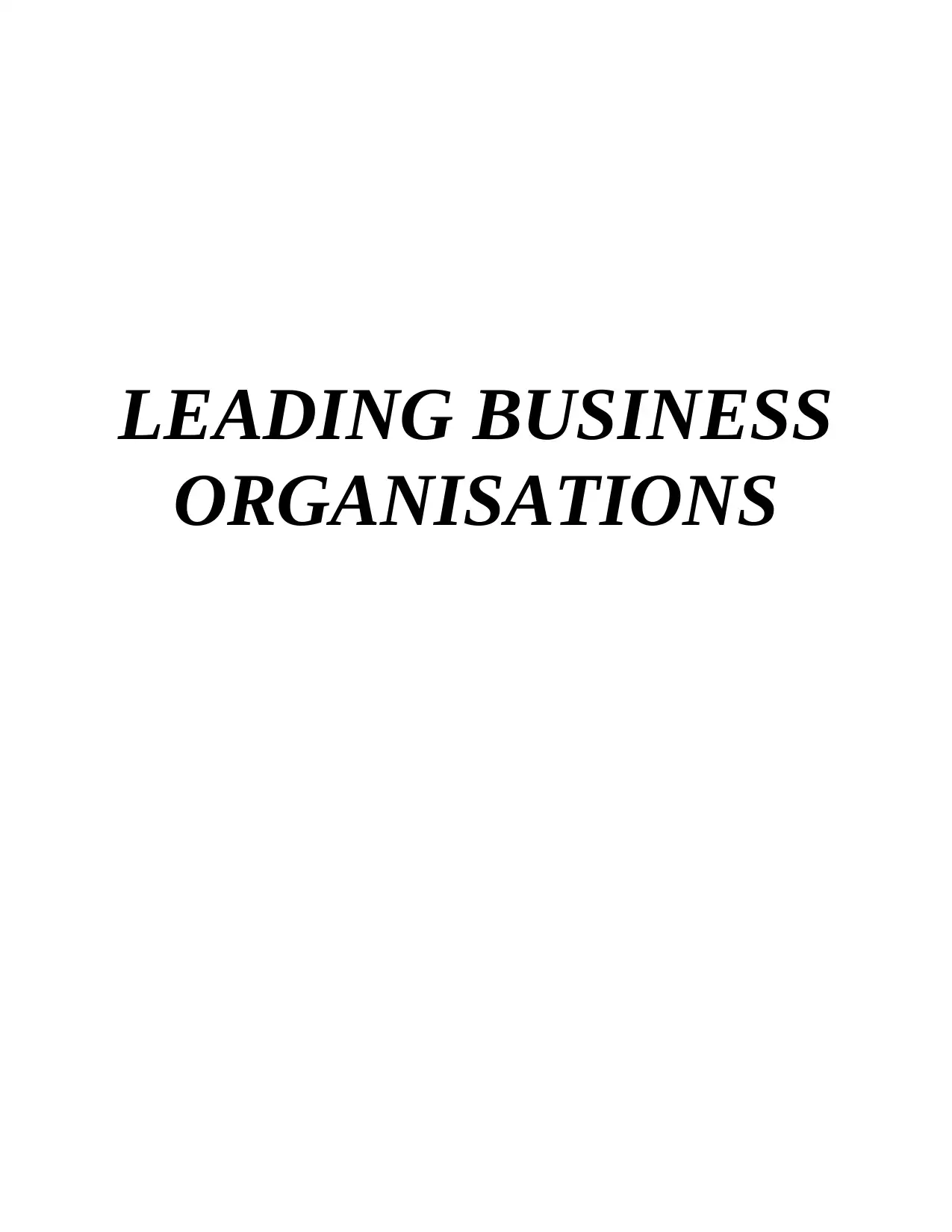
LEADING BUSINESS
ORGANISATIONS
ORGANISATIONS
Paraphrase This Document
Need a fresh take? Get an instant paraphrase of this document with our AI Paraphraser
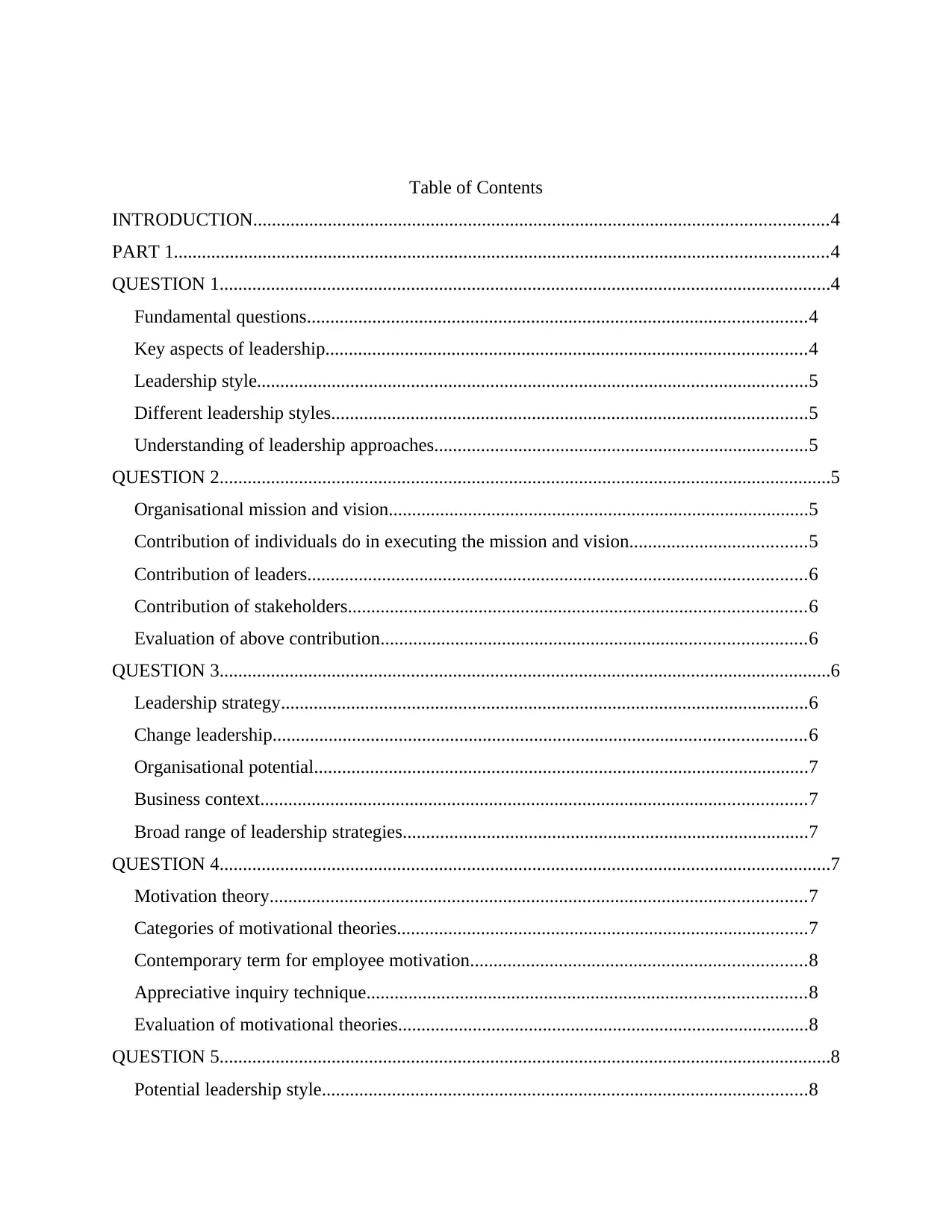
Table of Contents
INTRODUCTION...........................................................................................................................4
PART 1............................................................................................................................................4
QUESTION 1...................................................................................................................................4
Fundamental questions...........................................................................................................4
Key aspects of leadership.......................................................................................................4
Leadership style......................................................................................................................5
Different leadership styles......................................................................................................5
Understanding of leadership approaches................................................................................5
QUESTION 2...................................................................................................................................5
Organisational mission and vision..........................................................................................5
Contribution of individuals do in executing the mission and vision......................................5
Contribution of leaders...........................................................................................................6
Contribution of stakeholders..................................................................................................6
Evaluation of above contribution...........................................................................................6
QUESTION 3...................................................................................................................................6
Leadership strategy.................................................................................................................6
Change leadership..................................................................................................................6
Organisational potential..........................................................................................................7
Business context.....................................................................................................................7
Broad range of leadership strategies.......................................................................................7
QUESTION 4...................................................................................................................................7
Motivation theory...................................................................................................................7
Categories of motivational theories........................................................................................7
Contemporary term for employee motivation........................................................................8
Appreciative inquiry technique..............................................................................................8
Evaluation of motivational theories........................................................................................8
QUESTION 5...................................................................................................................................8
Potential leadership style........................................................................................................8
INTRODUCTION...........................................................................................................................4
PART 1............................................................................................................................................4
QUESTION 1...................................................................................................................................4
Fundamental questions...........................................................................................................4
Key aspects of leadership.......................................................................................................4
Leadership style......................................................................................................................5
Different leadership styles......................................................................................................5
Understanding of leadership approaches................................................................................5
QUESTION 2...................................................................................................................................5
Organisational mission and vision..........................................................................................5
Contribution of individuals do in executing the mission and vision......................................5
Contribution of leaders...........................................................................................................6
Contribution of stakeholders..................................................................................................6
Evaluation of above contribution...........................................................................................6
QUESTION 3...................................................................................................................................6
Leadership strategy.................................................................................................................6
Change leadership..................................................................................................................6
Organisational potential..........................................................................................................7
Business context.....................................................................................................................7
Broad range of leadership strategies.......................................................................................7
QUESTION 4...................................................................................................................................7
Motivation theory...................................................................................................................7
Categories of motivational theories........................................................................................7
Contemporary term for employee motivation........................................................................8
Appreciative inquiry technique..............................................................................................8
Evaluation of motivational theories........................................................................................8
QUESTION 5...................................................................................................................................8
Potential leadership style........................................................................................................8
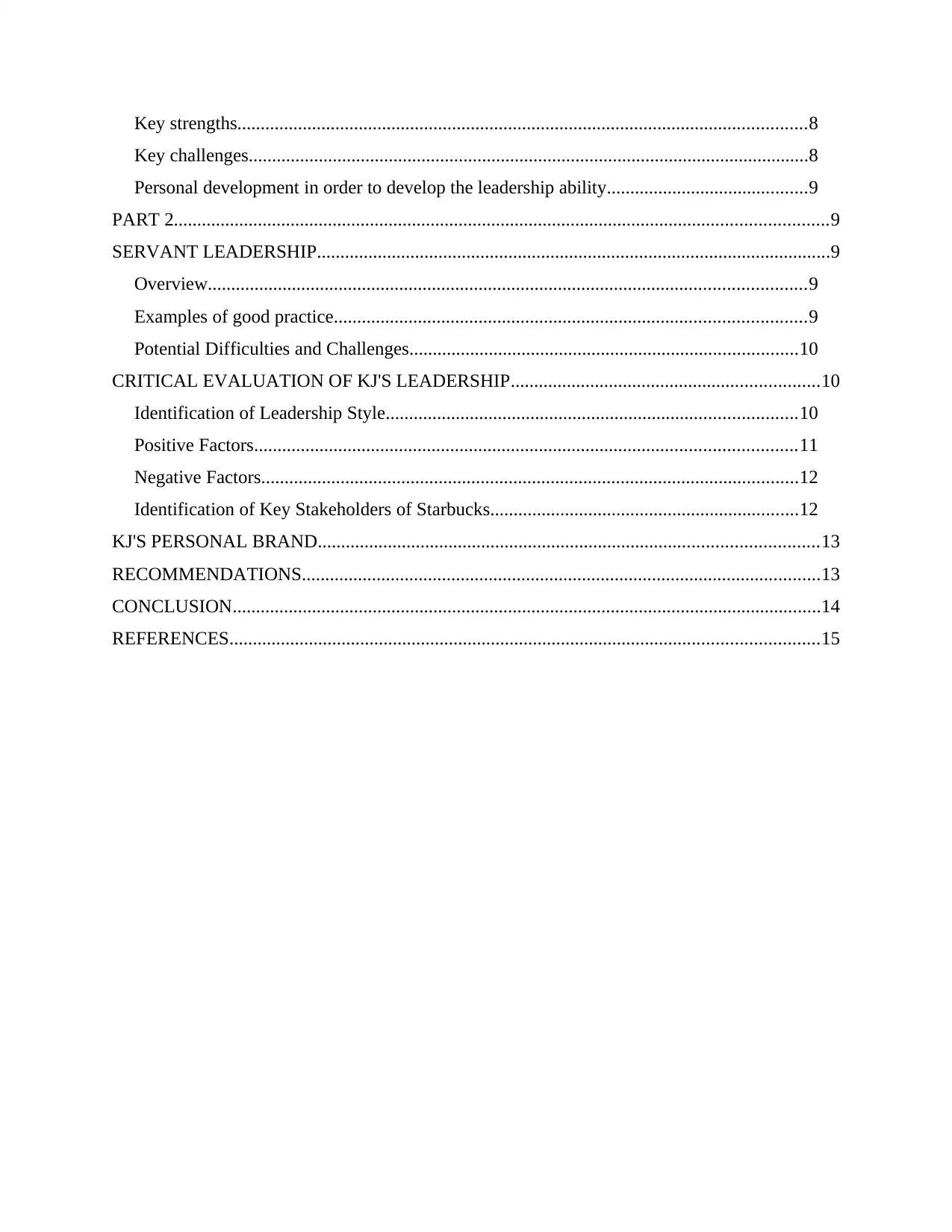
Key strengths..........................................................................................................................8
Key challenges........................................................................................................................8
Personal development in order to develop the leadership ability...........................................9
PART 2............................................................................................................................................9
SERVANT LEADERSHIP..............................................................................................................9
Overview................................................................................................................................9
Examples of good practice.....................................................................................................9
Potential Difficulties and Challenges...................................................................................10
CRITICAL EVALUATION OF KJ'S LEADERSHIP..................................................................10
Identification of Leadership Style........................................................................................10
Positive Factors....................................................................................................................11
Negative Factors...................................................................................................................12
Identification of Key Stakeholders of Starbucks..................................................................12
KJ'S PERSONAL BRAND...........................................................................................................13
RECOMMENDATIONS...............................................................................................................13
CONCLUSION..............................................................................................................................14
REFERENCES..............................................................................................................................15
Key challenges........................................................................................................................8
Personal development in order to develop the leadership ability...........................................9
PART 2............................................................................................................................................9
SERVANT LEADERSHIP..............................................................................................................9
Overview................................................................................................................................9
Examples of good practice.....................................................................................................9
Potential Difficulties and Challenges...................................................................................10
CRITICAL EVALUATION OF KJ'S LEADERSHIP..................................................................10
Identification of Leadership Style........................................................................................10
Positive Factors....................................................................................................................11
Negative Factors...................................................................................................................12
Identification of Key Stakeholders of Starbucks..................................................................12
KJ'S PERSONAL BRAND...........................................................................................................13
RECOMMENDATIONS...............................................................................................................13
CONCLUSION..............................................................................................................................14
REFERENCES..............................................................................................................................15
⊘ This is a preview!⊘
Do you want full access?
Subscribe today to unlock all pages.

Trusted by 1+ million students worldwide
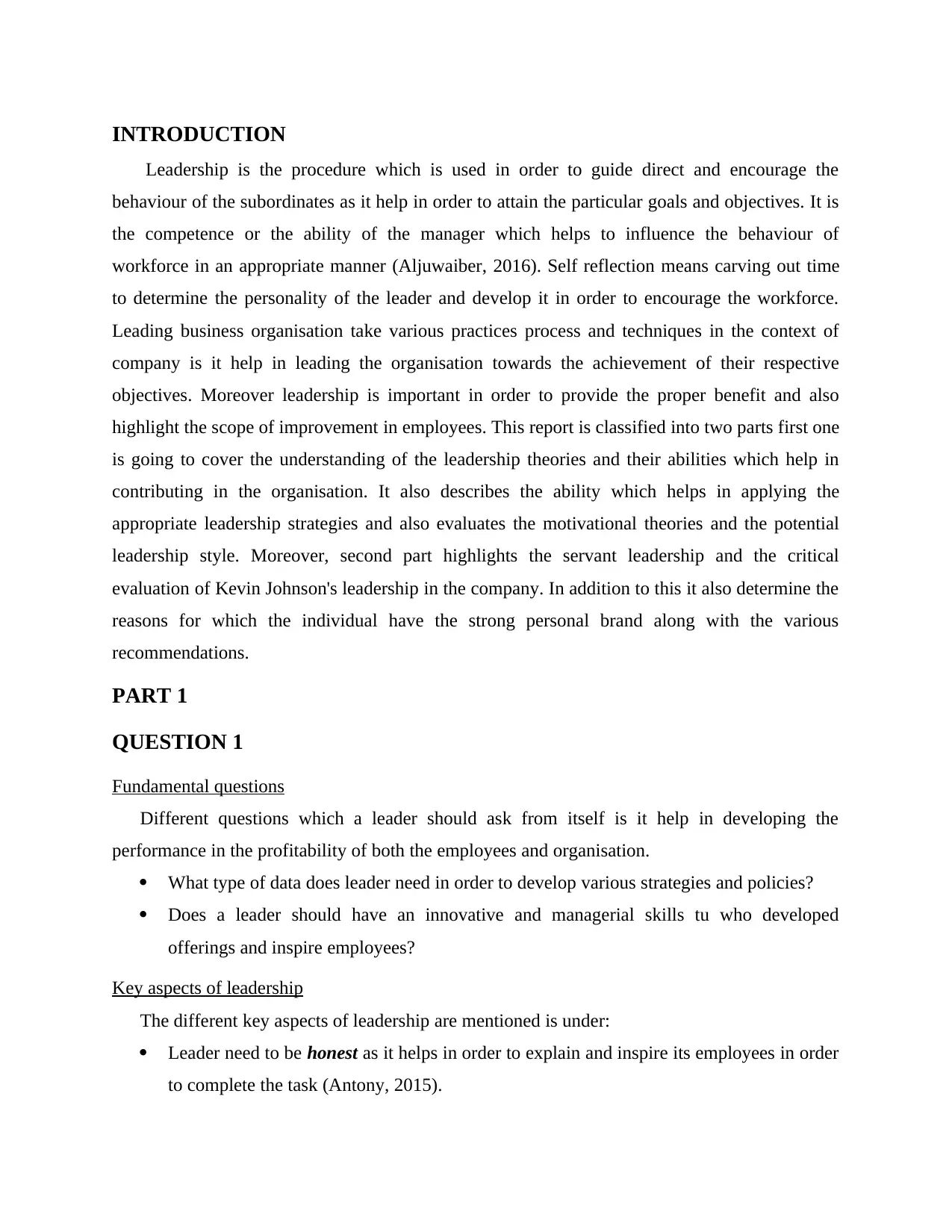
INTRODUCTION
Leadership is the procedure which is used in order to guide direct and encourage the
behaviour of the subordinates as it help in order to attain the particular goals and objectives. It is
the competence or the ability of the manager which helps to influence the behaviour of
workforce in an appropriate manner (Aljuwaiber, 2016). Self reflection means carving out time
to determine the personality of the leader and develop it in order to encourage the workforce.
Leading business organisation take various practices process and techniques in the context of
company is it help in leading the organisation towards the achievement of their respective
objectives. Moreover leadership is important in order to provide the proper benefit and also
highlight the scope of improvement in employees. This report is classified into two parts first one
is going to cover the understanding of the leadership theories and their abilities which help in
contributing in the organisation. It also describes the ability which helps in applying the
appropriate leadership strategies and also evaluates the motivational theories and the potential
leadership style. Moreover, second part highlights the servant leadership and the critical
evaluation of Kevin Johnson's leadership in the company. In addition to this it also determine the
reasons for which the individual have the strong personal brand along with the various
recommendations.
PART 1
QUESTION 1
Fundamental questions
Different questions which a leader should ask from itself is it help in developing the
performance in the profitability of both the employees and organisation.
What type of data does leader need in order to develop various strategies and policies?
Does a leader should have an innovative and managerial skills tu who developed
offerings and inspire employees?
Key aspects of leadership
The different key aspects of leadership are mentioned is under:
Leader need to be honest as it helps in order to explain and inspire its employees in order
to complete the task (Antony, 2015).
Leadership is the procedure which is used in order to guide direct and encourage the
behaviour of the subordinates as it help in order to attain the particular goals and objectives. It is
the competence or the ability of the manager which helps to influence the behaviour of
workforce in an appropriate manner (Aljuwaiber, 2016). Self reflection means carving out time
to determine the personality of the leader and develop it in order to encourage the workforce.
Leading business organisation take various practices process and techniques in the context of
company is it help in leading the organisation towards the achievement of their respective
objectives. Moreover leadership is important in order to provide the proper benefit and also
highlight the scope of improvement in employees. This report is classified into two parts first one
is going to cover the understanding of the leadership theories and their abilities which help in
contributing in the organisation. It also describes the ability which helps in applying the
appropriate leadership strategies and also evaluates the motivational theories and the potential
leadership style. Moreover, second part highlights the servant leadership and the critical
evaluation of Kevin Johnson's leadership in the company. In addition to this it also determine the
reasons for which the individual have the strong personal brand along with the various
recommendations.
PART 1
QUESTION 1
Fundamental questions
Different questions which a leader should ask from itself is it help in developing the
performance in the profitability of both the employees and organisation.
What type of data does leader need in order to develop various strategies and policies?
Does a leader should have an innovative and managerial skills tu who developed
offerings and inspire employees?
Key aspects of leadership
The different key aspects of leadership are mentioned is under:
Leader need to be honest as it helps in order to explain and inspire its employees in order
to complete the task (Antony, 2015).
Paraphrase This Document
Need a fresh take? Get an instant paraphrase of this document with our AI Paraphraser
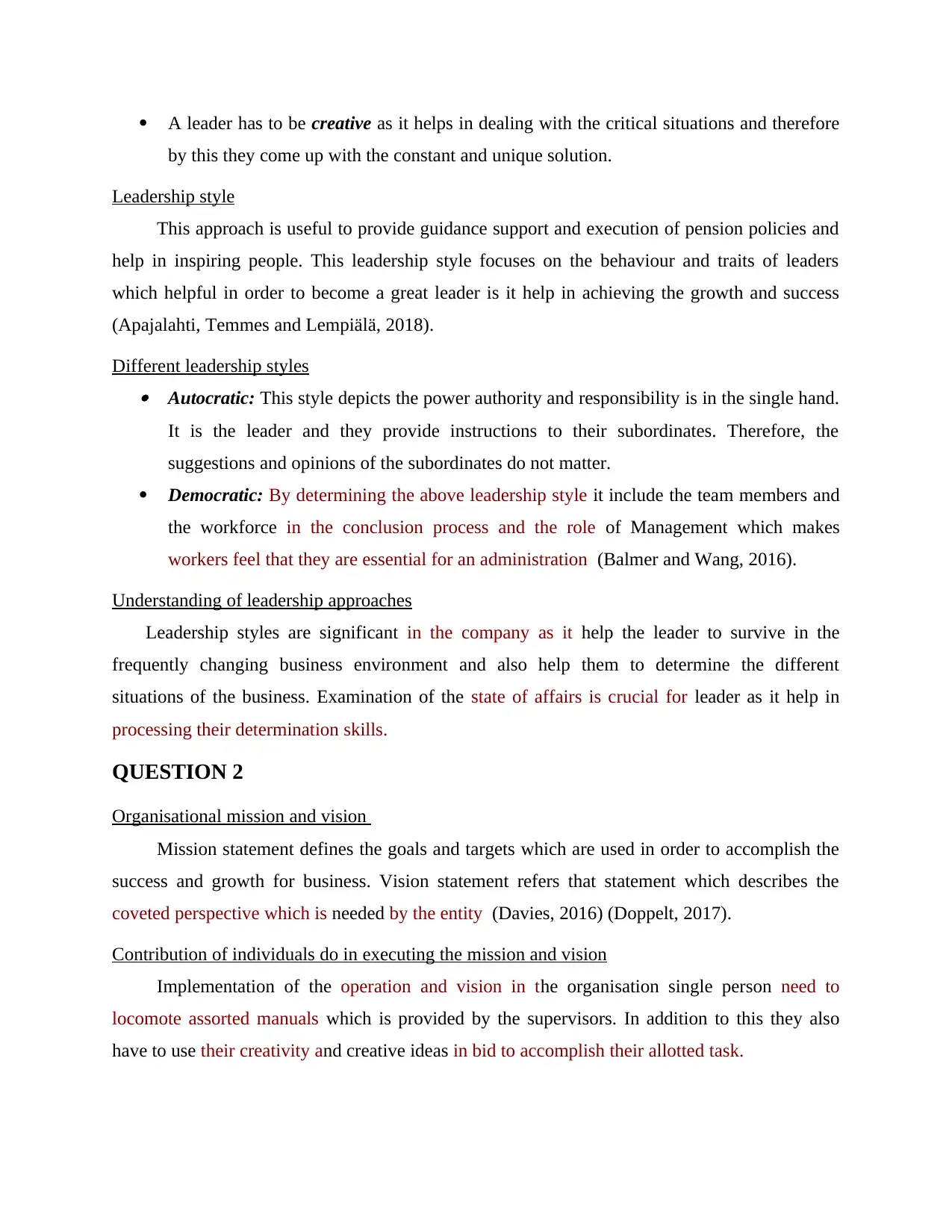
A leader has to be creative as it helps in dealing with the critical situations and therefore
by this they come up with the constant and unique solution.
Leadership style
This approach is useful to provide guidance support and execution of pension policies and
help in inspiring people. This leadership style focuses on the behaviour and traits of leaders
which helpful in order to become a great leader is it help in achieving the growth and success
(Apajalahti, Temmes and Lempiälä, 2018).
Different leadership styles Autocratic: This style depicts the power authority and responsibility is in the single hand.
It is the leader and they provide instructions to their subordinates. Therefore, the
suggestions and opinions of the subordinates do not matter.
Democratic: By determining the above leadership style it include the team members and
the workforce in the conclusion process and the role of Management which makes
workers feel that they are essential for an administration (Balmer and Wang, 2016).
Understanding of leadership approaches
Leadership styles are significant in the company as it help the leader to survive in the
frequently changing business environment and also help them to determine the different
situations of the business. Examination of the state of affairs is crucial for leader as it help in
processing their determination skills.
QUESTION 2
Organisational mission and vision
Mission statement defines the goals and targets which are used in order to accomplish the
success and growth for business. Vision statement refers that statement which describes the
coveted perspective which is needed by the entity (Davies, 2016) (Doppelt, 2017).
Contribution of individuals do in executing the mission and vision
Implementation of the operation and vision in the organisation single person need to
locomote assorted manuals which is provided by the supervisors. In addition to this they also
have to use their creativity and creative ideas in bid to accomplish their allotted task.
by this they come up with the constant and unique solution.
Leadership style
This approach is useful to provide guidance support and execution of pension policies and
help in inspiring people. This leadership style focuses on the behaviour and traits of leaders
which helpful in order to become a great leader is it help in achieving the growth and success
(Apajalahti, Temmes and Lempiälä, 2018).
Different leadership styles Autocratic: This style depicts the power authority and responsibility is in the single hand.
It is the leader and they provide instructions to their subordinates. Therefore, the
suggestions and opinions of the subordinates do not matter.
Democratic: By determining the above leadership style it include the team members and
the workforce in the conclusion process and the role of Management which makes
workers feel that they are essential for an administration (Balmer and Wang, 2016).
Understanding of leadership approaches
Leadership styles are significant in the company as it help the leader to survive in the
frequently changing business environment and also help them to determine the different
situations of the business. Examination of the state of affairs is crucial for leader as it help in
processing their determination skills.
QUESTION 2
Organisational mission and vision
Mission statement defines the goals and targets which are used in order to accomplish the
success and growth for business. Vision statement refers that statement which describes the
coveted perspective which is needed by the entity (Davies, 2016) (Doppelt, 2017).
Contribution of individuals do in executing the mission and vision
Implementation of the operation and vision in the organisation single person need to
locomote assorted manuals which is provided by the supervisors. In addition to this they also
have to use their creativity and creative ideas in bid to accomplish their allotted task.
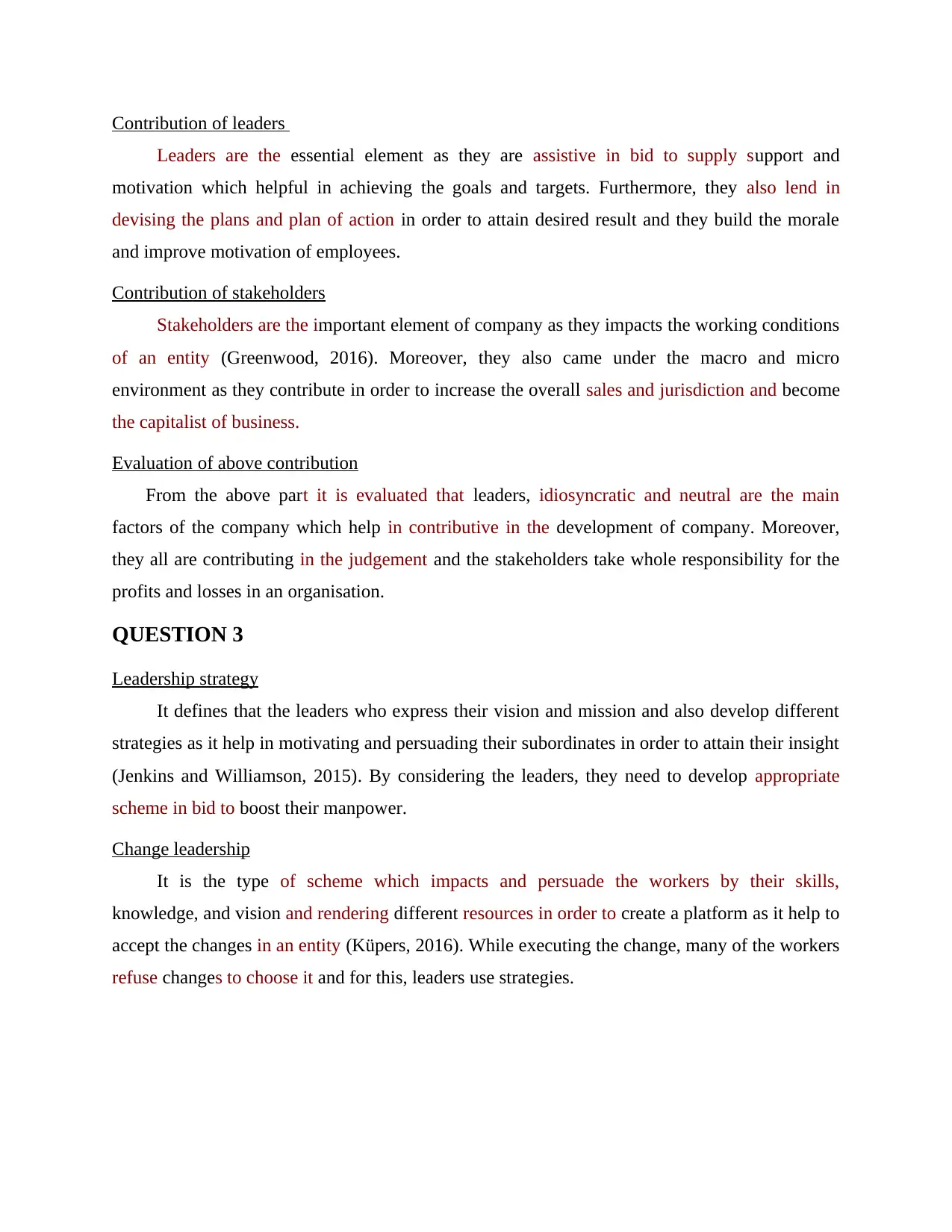
Contribution of leaders
Leaders are the essential element as they are assistive in bid to supply support and
motivation which helpful in achieving the goals and targets. Furthermore, they also lend in
devising the plans and plan of action in order to attain desired result and they build the morale
and improve motivation of employees.
Contribution of stakeholders
Stakeholders are the important element of company as they impacts the working conditions
of an entity (Greenwood, 2016). Moreover, they also came under the macro and micro
environment as they contribute in order to increase the overall sales and jurisdiction and become
the capitalist of business.
Evaluation of above contribution
From the above part it is evaluated that leaders, idiosyncratic and neutral are the main
factors of the company which help in contributive in the development of company. Moreover,
they all are contributing in the judgement and the stakeholders take whole responsibility for the
profits and losses in an organisation.
QUESTION 3
Leadership strategy
It defines that the leaders who express their vision and mission and also develop different
strategies as it help in motivating and persuading their subordinates in order to attain their insight
(Jenkins and Williamson, 2015). By considering the leaders, they need to develop appropriate
scheme in bid to boost their manpower.
Change leadership
It is the type of scheme which impacts and persuade the workers by their skills,
knowledge, and vision and rendering different resources in order to create a platform as it help to
accept the changes in an entity (Küpers, 2016). While executing the change, many of the workers
refuse changes to choose it and for this, leaders use strategies.
Leaders are the essential element as they are assistive in bid to supply support and
motivation which helpful in achieving the goals and targets. Furthermore, they also lend in
devising the plans and plan of action in order to attain desired result and they build the morale
and improve motivation of employees.
Contribution of stakeholders
Stakeholders are the important element of company as they impacts the working conditions
of an entity (Greenwood, 2016). Moreover, they also came under the macro and micro
environment as they contribute in order to increase the overall sales and jurisdiction and become
the capitalist of business.
Evaluation of above contribution
From the above part it is evaluated that leaders, idiosyncratic and neutral are the main
factors of the company which help in contributive in the development of company. Moreover,
they all are contributing in the judgement and the stakeholders take whole responsibility for the
profits and losses in an organisation.
QUESTION 3
Leadership strategy
It defines that the leaders who express their vision and mission and also develop different
strategies as it help in motivating and persuading their subordinates in order to attain their insight
(Jenkins and Williamson, 2015). By considering the leaders, they need to develop appropriate
scheme in bid to boost their manpower.
Change leadership
It is the type of scheme which impacts and persuade the workers by their skills,
knowledge, and vision and rendering different resources in order to create a platform as it help to
accept the changes in an entity (Küpers, 2016). While executing the change, many of the workers
refuse changes to choose it and for this, leaders use strategies.
⊘ This is a preview!⊘
Do you want full access?
Subscribe today to unlock all pages.

Trusted by 1+ million students worldwide

Organisational potential
It defines the ratio of the company which is useful in the attainment of various goals and
objectives of business unit (Millar, Chen and Waller, 2017). It is done because of the change
process and use to determine and examine the situation of company.
Business context
Business context is the perceptive of various section which impacts the decisions of
business which are successful in bid to attain the goals and accusative of company (Moxen and
Strachan, 2017). Moreover, it is a document which helps in order to monitor and control the
advancement of product.
Broad range of leadership strategies
These schemes are helpful in bid to improve the presentation of single person as it impacts
the ratio of an organisation. Hence, strategies are help in describing the scope of different
purpose in the various business context.
QUESTION 4
Motivation theory
Motivation theory is useful in encouraging and motivating the workforce in order to
increase the overall performance of employees (Scallon and Sten, 2017). It depicts the different
factors which represents the requirements of employees and also impacts the total performance
of an organisation.
Categories of motivational theories Intrinsic theory: It defines those components which impacts the internal factors of the
company. These are the section which satisfy the requirements of single by providing the
rewards and recognition to employees (Simões, Gomes and Yasin, 2016).
Extrinsic theory: It define the conduct which increases the overall presentation of
workers by providing the tangible recognitions such as money, vacations, promotion and
many more. Hence, it motivates the employees to work properly and complete their work
on time.
It defines the ratio of the company which is useful in the attainment of various goals and
objectives of business unit (Millar, Chen and Waller, 2017). It is done because of the change
process and use to determine and examine the situation of company.
Business context
Business context is the perceptive of various section which impacts the decisions of
business which are successful in bid to attain the goals and accusative of company (Moxen and
Strachan, 2017). Moreover, it is a document which helps in order to monitor and control the
advancement of product.
Broad range of leadership strategies
These schemes are helpful in bid to improve the presentation of single person as it impacts
the ratio of an organisation. Hence, strategies are help in describing the scope of different
purpose in the various business context.
QUESTION 4
Motivation theory
Motivation theory is useful in encouraging and motivating the workforce in order to
increase the overall performance of employees (Scallon and Sten, 2017). It depicts the different
factors which represents the requirements of employees and also impacts the total performance
of an organisation.
Categories of motivational theories Intrinsic theory: It defines those components which impacts the internal factors of the
company. These are the section which satisfy the requirements of single by providing the
rewards and recognition to employees (Simões, Gomes and Yasin, 2016).
Extrinsic theory: It define the conduct which increases the overall presentation of
workers by providing the tangible recognitions such as money, vacations, promotion and
many more. Hence, it motivates the employees to work properly and complete their work
on time.
Paraphrase This Document
Need a fresh take? Get an instant paraphrase of this document with our AI Paraphraser
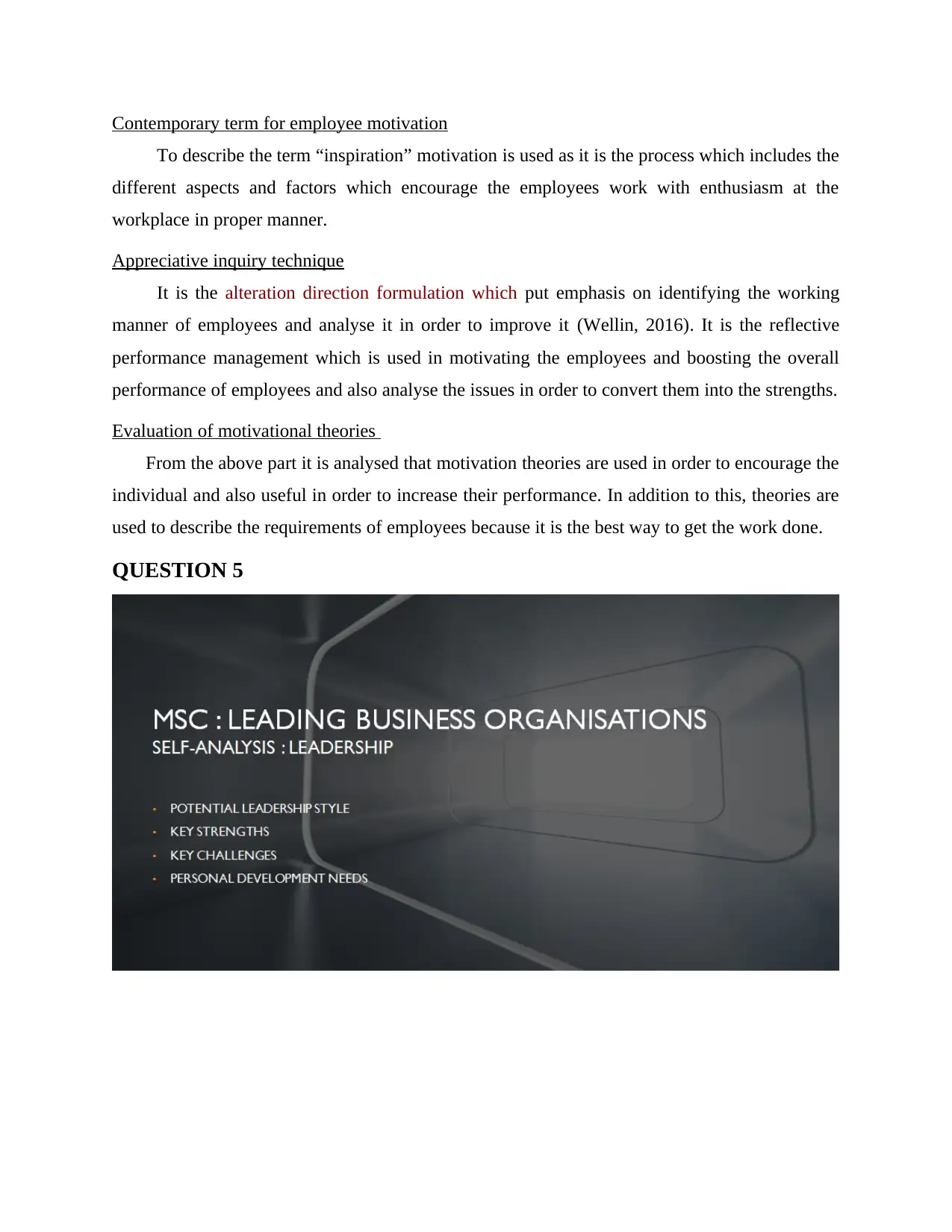
Contemporary term for employee motivation
To describe the term “inspiration” motivation is used as it is the process which includes the
different aspects and factors which encourage the employees work with enthusiasm at the
workplace in proper manner.
Appreciative inquiry technique
It is the alteration direction formulation which put emphasis on identifying the working
manner of employees and analyse it in order to improve it (Wellin, 2016). It is the reflective
performance management which is used in motivating the employees and boosting the overall
performance of employees and also analyse the issues in order to convert them into the strengths.
Evaluation of motivational theories
From the above part it is analysed that motivation theories are used in order to encourage the
individual and also useful in order to increase their performance. In addition to this, theories are
used to describe the requirements of employees because it is the best way to get the work done.
QUESTION 5
To describe the term “inspiration” motivation is used as it is the process which includes the
different aspects and factors which encourage the employees work with enthusiasm at the
workplace in proper manner.
Appreciative inquiry technique
It is the alteration direction formulation which put emphasis on identifying the working
manner of employees and analyse it in order to improve it (Wellin, 2016). It is the reflective
performance management which is used in motivating the employees and boosting the overall
performance of employees and also analyse the issues in order to convert them into the strengths.
Evaluation of motivational theories
From the above part it is analysed that motivation theories are used in order to encourage the
individual and also useful in order to increase their performance. In addition to this, theories are
used to describe the requirements of employees because it is the best way to get the work done.
QUESTION 5

Potential leadership style
Key strengths
Key strengths
⊘ This is a preview!⊘
Do you want full access?
Subscribe today to unlock all pages.

Trusted by 1+ million students worldwide
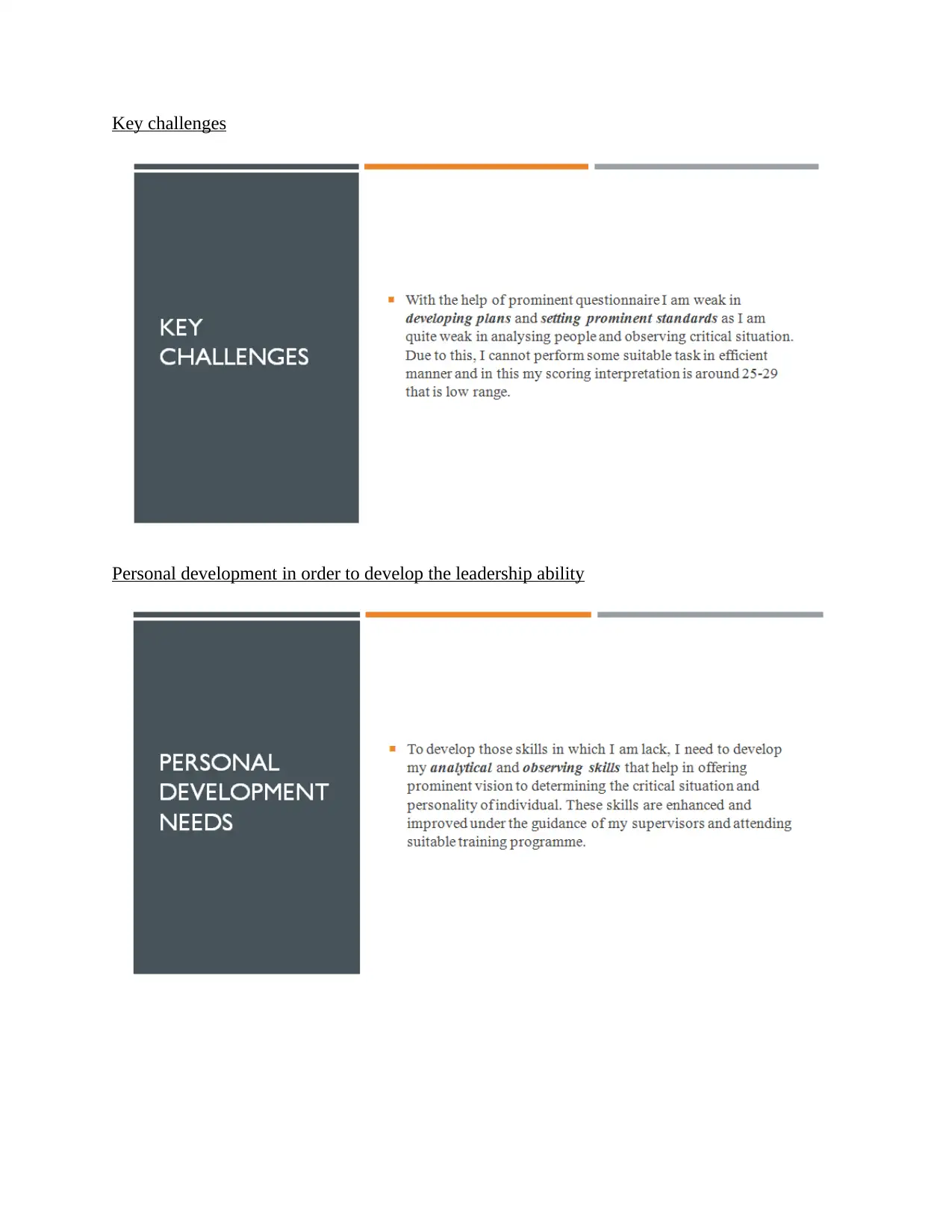
Key challenges
Personal development in order to develop the leadership ability
Personal development in order to develop the leadership ability
Paraphrase This Document
Need a fresh take? Get an instant paraphrase of this document with our AI Paraphraser
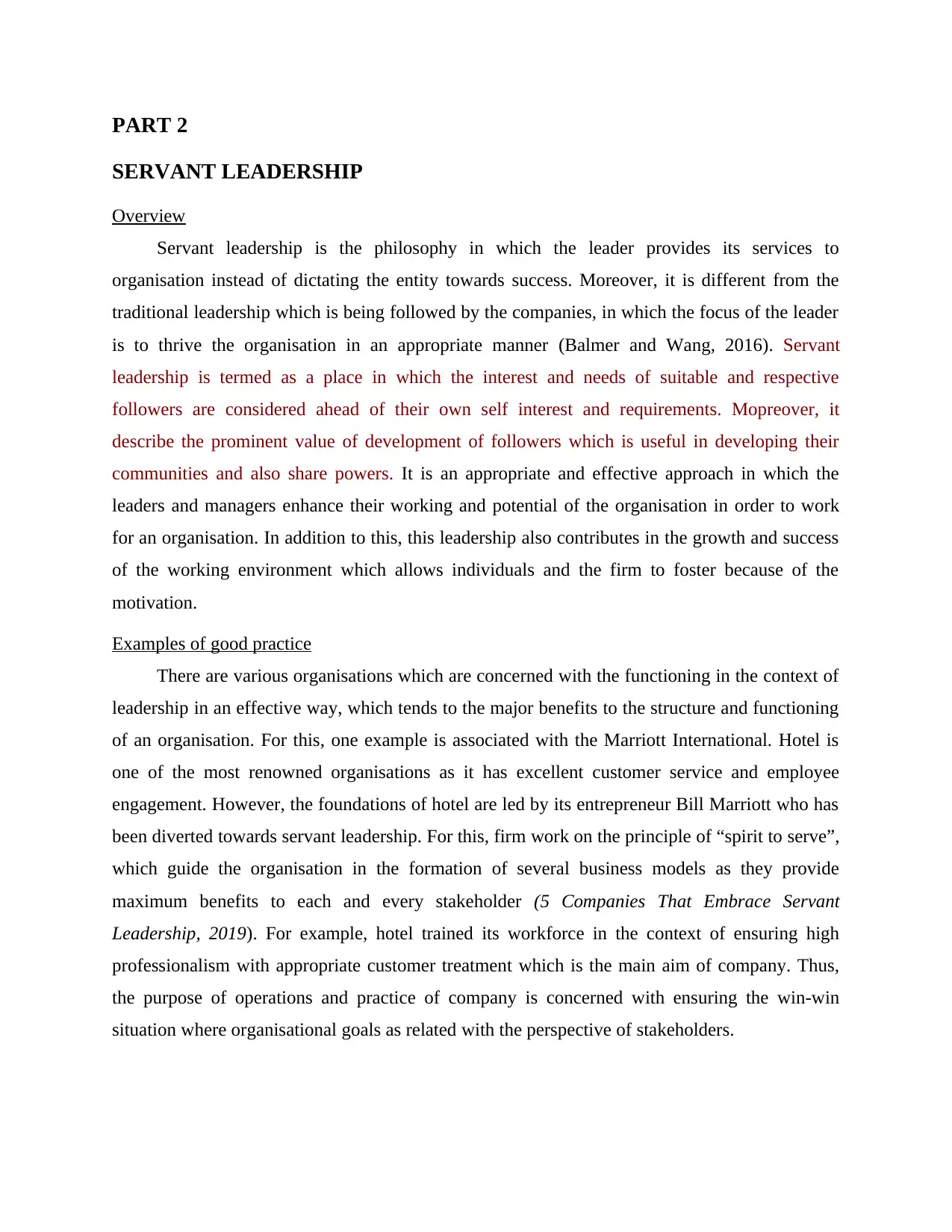
PART 2
SERVANT LEADERSHIP
Overview
Servant leadership is the philosophy in which the leader provides its services to
organisation instead of dictating the entity towards success. Moreover, it is different from the
traditional leadership which is being followed by the companies, in which the focus of the leader
is to thrive the organisation in an appropriate manner (Balmer and Wang, 2016). Servant
leadership is termed as a place in which the interest and needs of suitable and respective
followers are considered ahead of their own self interest and requirements. Mopreover, it
describe the prominent value of development of followers which is useful in developing their
communities and also share powers. It is an appropriate and effective approach in which the
leaders and managers enhance their working and potential of the organisation in order to work
for an organisation. In addition to this, this leadership also contributes in the growth and success
of the working environment which allows individuals and the firm to foster because of the
motivation.
Examples of good practice
There are various organisations which are concerned with the functioning in the context of
leadership in an effective way, which tends to the major benefits to the structure and functioning
of an organisation. For this, one example is associated with the Marriott International. Hotel is
one of the most renowned organisations as it has excellent customer service and employee
engagement. However, the foundations of hotel are led by its entrepreneur Bill Marriott who has
been diverted towards servant leadership. For this, firm work on the principle of “spirit to serve”,
which guide the organisation in the formation of several business models as they provide
maximum benefits to each and every stakeholder (5 Companies That Embrace Servant
Leadership, 2019). For example, hotel trained its workforce in the context of ensuring high
professionalism with appropriate customer treatment which is the main aim of company. Thus,
the purpose of operations and practice of company is concerned with ensuring the win-win
situation where organisational goals as related with the perspective of stakeholders.
SERVANT LEADERSHIP
Overview
Servant leadership is the philosophy in which the leader provides its services to
organisation instead of dictating the entity towards success. Moreover, it is different from the
traditional leadership which is being followed by the companies, in which the focus of the leader
is to thrive the organisation in an appropriate manner (Balmer and Wang, 2016). Servant
leadership is termed as a place in which the interest and needs of suitable and respective
followers are considered ahead of their own self interest and requirements. Mopreover, it
describe the prominent value of development of followers which is useful in developing their
communities and also share powers. It is an appropriate and effective approach in which the
leaders and managers enhance their working and potential of the organisation in order to work
for an organisation. In addition to this, this leadership also contributes in the growth and success
of the working environment which allows individuals and the firm to foster because of the
motivation.
Examples of good practice
There are various organisations which are concerned with the functioning in the context of
leadership in an effective way, which tends to the major benefits to the structure and functioning
of an organisation. For this, one example is associated with the Marriott International. Hotel is
one of the most renowned organisations as it has excellent customer service and employee
engagement. However, the foundations of hotel are led by its entrepreneur Bill Marriott who has
been diverted towards servant leadership. For this, firm work on the principle of “spirit to serve”,
which guide the organisation in the formation of several business models as they provide
maximum benefits to each and every stakeholder (5 Companies That Embrace Servant
Leadership, 2019). For example, hotel trained its workforce in the context of ensuring high
professionalism with appropriate customer treatment which is the main aim of company. Thus,
the purpose of operations and practice of company is concerned with ensuring the win-win
situation where organisational goals as related with the perspective of stakeholders.
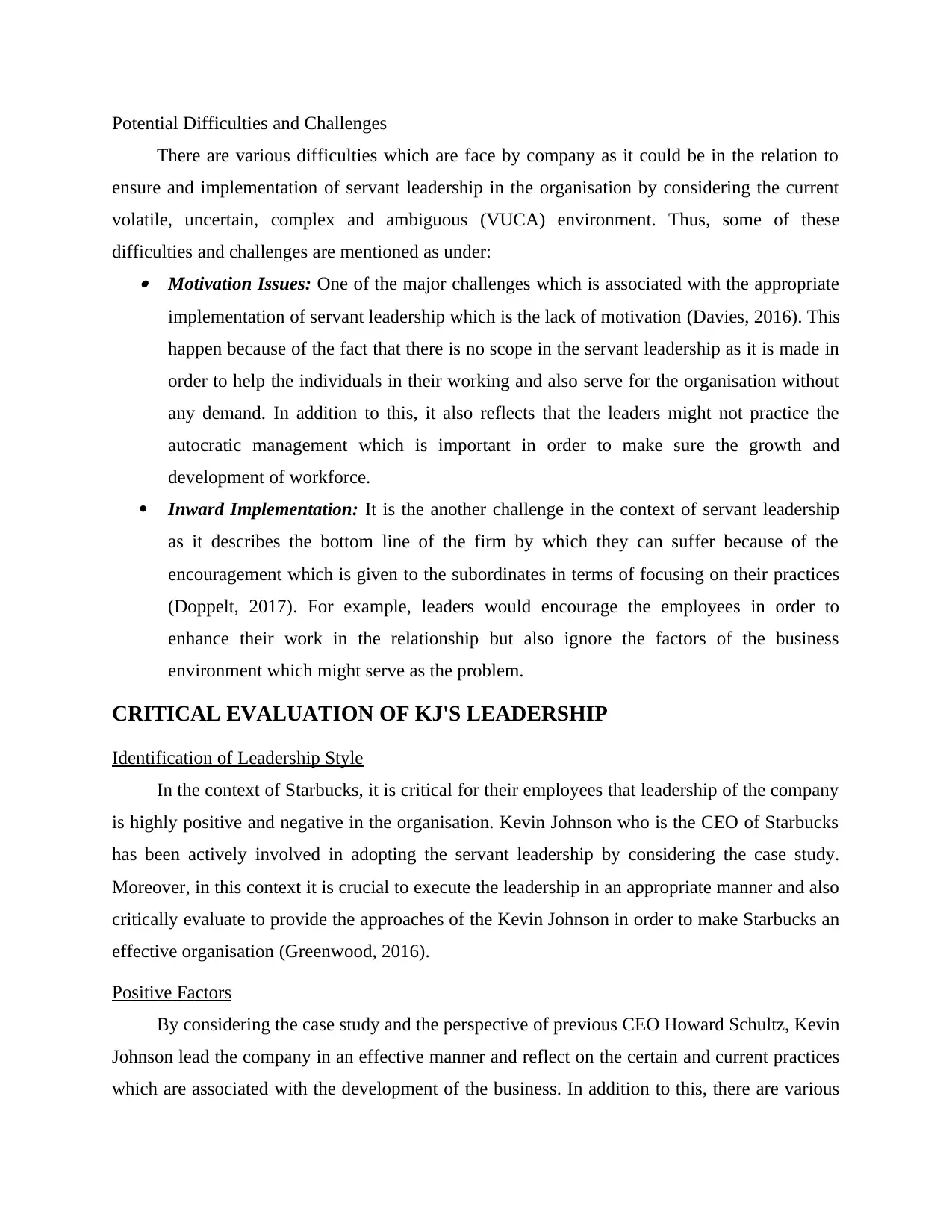
Potential Difficulties and Challenges
There are various difficulties which are face by company as it could be in the relation to
ensure and implementation of servant leadership in the organisation by considering the current
volatile, uncertain, complex and ambiguous (VUCA) environment. Thus, some of these
difficulties and challenges are mentioned as under: Motivation Issues: One of the major challenges which is associated with the appropriate
implementation of servant leadership which is the lack of motivation (Davies, 2016). This
happen because of the fact that there is no scope in the servant leadership as it is made in
order to help the individuals in their working and also serve for the organisation without
any demand. In addition to this, it also reflects that the leaders might not practice the
autocratic management which is important in order to make sure the growth and
development of workforce.
Inward Implementation: It is the another challenge in the context of servant leadership
as it describes the bottom line of the firm by which they can suffer because of the
encouragement which is given to the subordinates in terms of focusing on their practices
(Doppelt, 2017). For example, leaders would encourage the employees in order to
enhance their work in the relationship but also ignore the factors of the business
environment which might serve as the problem.
CRITICAL EVALUATION OF KJ'S LEADERSHIP
Identification of Leadership Style
In the context of Starbucks, it is critical for their employees that leadership of the company
is highly positive and negative in the organisation. Kevin Johnson who is the CEO of Starbucks
has been actively involved in adopting the servant leadership by considering the case study.
Moreover, in this context it is crucial to execute the leadership in an appropriate manner and also
critically evaluate to provide the approaches of the Kevin Johnson in order to make Starbucks an
effective organisation (Greenwood, 2016).
Positive Factors
By considering the case study and the perspective of previous CEO Howard Schultz, Kevin
Johnson lead the company in an effective manner and reflect on the certain and current practices
which are associated with the development of the business. In addition to this, there are various
There are various difficulties which are face by company as it could be in the relation to
ensure and implementation of servant leadership in the organisation by considering the current
volatile, uncertain, complex and ambiguous (VUCA) environment. Thus, some of these
difficulties and challenges are mentioned as under: Motivation Issues: One of the major challenges which is associated with the appropriate
implementation of servant leadership which is the lack of motivation (Davies, 2016). This
happen because of the fact that there is no scope in the servant leadership as it is made in
order to help the individuals in their working and also serve for the organisation without
any demand. In addition to this, it also reflects that the leaders might not practice the
autocratic management which is important in order to make sure the growth and
development of workforce.
Inward Implementation: It is the another challenge in the context of servant leadership
as it describes the bottom line of the firm by which they can suffer because of the
encouragement which is given to the subordinates in terms of focusing on their practices
(Doppelt, 2017). For example, leaders would encourage the employees in order to
enhance their work in the relationship but also ignore the factors of the business
environment which might serve as the problem.
CRITICAL EVALUATION OF KJ'S LEADERSHIP
Identification of Leadership Style
In the context of Starbucks, it is critical for their employees that leadership of the company
is highly positive and negative in the organisation. Kevin Johnson who is the CEO of Starbucks
has been actively involved in adopting the servant leadership by considering the case study.
Moreover, in this context it is crucial to execute the leadership in an appropriate manner and also
critically evaluate to provide the approaches of the Kevin Johnson in order to make Starbucks an
effective organisation (Greenwood, 2016).
Positive Factors
By considering the case study and the perspective of previous CEO Howard Schultz, Kevin
Johnson lead the company in an effective manner and reflect on the certain and current practices
which are associated with the development of the business. In addition to this, there are various
⊘ This is a preview!⊘
Do you want full access?
Subscribe today to unlock all pages.

Trusted by 1+ million students worldwide
1 out of 18
Related Documents
Your All-in-One AI-Powered Toolkit for Academic Success.
+13062052269
info@desklib.com
Available 24*7 on WhatsApp / Email
![[object Object]](/_next/static/media/star-bottom.7253800d.svg)
Unlock your academic potential
Copyright © 2020–2025 A2Z Services. All Rights Reserved. Developed and managed by ZUCOL.





